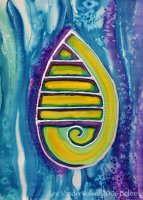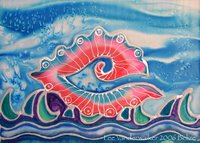

I finally caught a break with MCS and United Nations Baby on Caye Caulker, it was just me and Bigness at the house in the bush and he was busy killing fire ants and spiders for 2 days. I was finally able to get some head space and created these 4 small paintings for the store. I had the basic ideas sketched for months and months and even used some of them for the Alamina Beach House purple bedroom art. I love Mesoamerican art which spans from the northwestern regions of Mexico to the southern Yucatan penninsula.

Mesoamerican Butterfly on silk
Mesoamerican Snail on silk I copied this following information from the Dharma Trading Website, where I buy most of my supplies for silk painting.
I copied this following information from the Dharma Trading Website, where I buy most of my supplies for silk painting.
The Serti (closing or fence) technique is the silk painting technique where designs are formed with gutta or water-based resists, which are applied to white silk that has been pre-washed, dried and stretched (on a stretcher). Once the gutta or water-based resist has dried, it acts as a barrier for the dye or paint—keeping the color within the outlined areas of the design and allowing you to achieve sharply defined borders. (Without this barrier, the dye or paint would flow into more of an abstract, undefined pattern.) After the dye or paint has been properly set, the clear gutta or resist is removed and a defining line the color of the original fabric remains. Colored guttas and resists are also available that are meant to remain in the fabric.
Detailed patterns without resists can be achieved by instead priming the prewashed and stretched silk with a stop-flow primer which is left to dry before painting on the dyes or paints. The color will stay where you put it, rather than migrating. Allows for freehand painting without gutta or water-soluble resists. Think of stop-flow primers as starch-like sizing to prepare the canvas with. They wash out in the end.
Watercolor-like effects can be achieved by applying dye or paint to silk that has been pre-washed and put on stretcher bars whether or not you are using resists (but not if you are using stop-flow). Dyes or paints are applied to the silk with a paint brush, mist sprayer, eye dropper, or other tools to achieve abstract effects. Spraying the silk lightly with water before adding color increases the flow of the dye or paint. Sprinkling silk salt on the piece when still wet, and leaving till completely dry before brushing off the salt, produces interesting textural effects. Applying alcohol to dye-painted silk also creates beautiful effects.
Y'know, you really are inspiring, all this work, living, enjoying life, your gallery, so much you do and accomplish.
ReplyDeleteAnd I thought embroidery is a lot of work, which is what I'm doing right now to a wall hanging. I don't paint. I'm not even a quarter as talented as you with designing either.
Beautiful!
ReplyDeletei love the first two silk-paintings and as an ex-silk painter myself, i know how long a painting can take.
ReplyDeletedo continue!
Lee, these are beautiful works! I love the colours and shapes! So you!
ReplyDelete